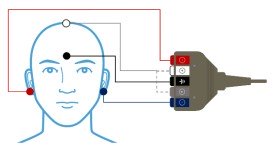Late Latency Responses (LLR)
Evoked Potentials Guides
Overview
Late Latency Responses (LLR) are responses to auditory stimuli that occur between 50 and 300 msec after stimulation. The LLR originates from the auditory cortex and can assist in evaluating patients with suspected auditory processing deficits, cortical lesions and when presented in sound field may be used for hearing verification.
The patient should be alert and awake during the duration of the test and should be sitting up in a chair or recliner. It is not necessary for the patient to attend to the stimulus.
The electrode placement is the same as it is for MLR recordings.
Common Test Settings
• Stimulus: 500 Hz Tone Burst
• Duration: 20 cycles
• Envelop: Blackman
• Phase: Alternating
• Intensity: 70 dBnHL
• Transducer: Insert Earphones
• Rate: 1.1 clicks/sec
• Sweeps: 250, replicated
• Gain: 50k
• High Pass Filter: 1 Hz
• Low Pass Filter: 30 Hz
• Window: 512 msec
Like the MLR, the LLR response consists of positive (P) and negative (N) peaks that occur after stimulation:
• P1 - occurs about 50 - 80 msec
• N1 - occurs about 100 - 150 msec
• P2 - occurs about 150 - 200 msec
• N2 - occurs about 180 - 250 msec
An example of an LLR response is below. Reduced amplitudes, prolonged latencies, asymmetries and absence of the LLR may be used when analyzing test results.

P300
The P300 is a late latency response and a test of cortical function. The P300 is different than other evoked potential tests because it requires presenting 2 different test stimuli using an ‘oddball’ paradigm. An oddball paradigm means one stimulus is presented frequently while the other stimulus is presented infrequently and is considered the ‘oddball’ stimulus. The frequent stimulus is presented 80% of the time and the infrequent stimulus presented 20% of the time. It is considered a cognitive response because the patient must ‘attend to’ or ‘listen for’ the infrequent stimulus in order to elicit the response. The P300 originates from the auditory cortex and may assist in evaluating patients with suspected auditory processing deficits and cortical lesions.
The patient must be alert and attending to the stimuli during the test. It is best if they are sitting up in a chair. Instruct the patient to ‘listen’ carefully to the stimuli and count the number of times they hear a sound that is different. The purpose of this is to ensure the patient remains alert during the test.
Electrodes are placed in the same locations for patients of all ages. Since the P300 is a cortical response it is recommended that the active (+) electrode be placed at Cz to obtain the largest amplitudes.

Test Settings
• Protocol Auditory Modality - P300
• Frequent Stimulus (80%): 1000 Hz Tone
• Infrequent Stimulus (20%): 2000 Hz Tone
• Phase: Alternating
• Intensity: 80 dBnHL
• Transducer: Insert Earphones
• Rate: 1.1 clicks/sec
• Sweeps: 25*
• Gain: 50k
• High Pass Filter: 1 Hz
• Low Pass Filter: 30 Hz
• Window: 512 msec
NOTE: The sweep number corresponds to the number of infrequent stimulations.
The P300 requires the patient to remain alert during the test in order to elicit the response. Because of this the patient may fatigue quickly. It is recommended to record multiple waveforms using a small number of sweeps (allowing the patient to rest in between collections) and then adding the responses together.
The infrequent waveform is the P300 (cognitive response to the oddball stimulus.) The P300 (P3) is marked on the infrequent waveform at a latency of about 300 msec (250-600 msec range.) The waveforms for the frequent stimulus are not used in the analysis.
Reduced amplitudes, prolonged latencies and absence of the P300 may be used when analyzing test results. It is important to keep in mind that the patient’s inattention to the task will have a direct effect on the quality of the test results.
MMN
There is considerable research using MMN in many areas such as assessing patients with schizophrenia, dementia, as well as speech perception and central auditory processing disorders. A thorough literature review is recommended prior to implementing MMN in a test battery.
Mismatch negativity (MMN) is a late latency response that is elicited in the same way as the P300 via the oddball paradigm. It is different than the P300 because attention to the test stimulus is not required meaning the patient does not have to ‘listen for’ the odd stimulus. It reflects automatic discrimination or ‘preattention’ of test stimuli generated in the auditory cortex. The MMN is obtained by subtracting the frequent waveform from the infrequent waveform and results in a ‘negative’ peak or component that occurs around 100–250 msec.
Unlike the P300, the patient does not have to attend to or pay attention to the test stimuli. The patient should be placed in a comfortable position and be instructed to relax during the test. Since the MMN is a cortical response it is recommended that the active (+) electrode be placed at Cz to obtain the largest amplitudes.

Common Test Settings
• Frequent Stimulus (80%): Tone or Speech Sound
• Infrequent Stimulus (20%): Tone or Speech Sound
• Phase: Alternating
• Intensity: 70 dBnHL
• Transducer: Insert Earphones
• Rate: 1.1 clicks/sec
• Sweeps: 100
• Gain: 50k
• High Pass Filter: 1 Hz
• Low Pass Filter: 30 Hz
• Window: 512 msec
The MMN is obtained by subtracting the frequent waveform from the infrequent waveform to obtain the “difference waveform.”

MMN area, latency and amplitude and may all be considered when analyzing the test results.